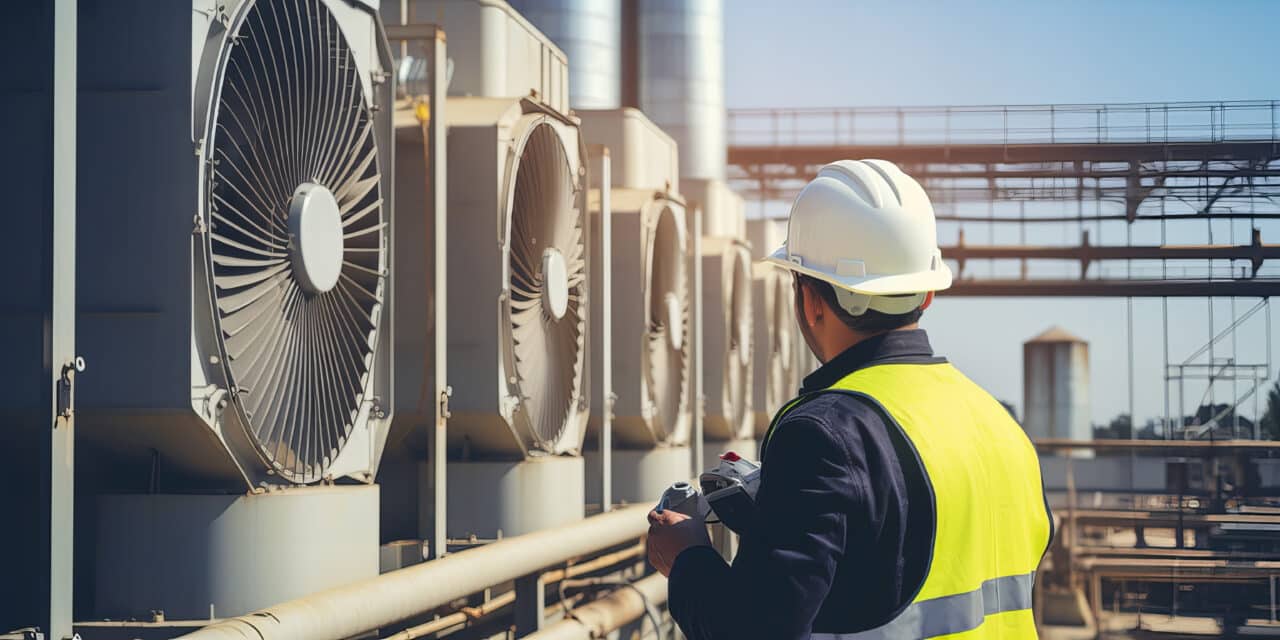Whether you manage 5,000 or 500,000 square feet, your commercial outdoor air conditioner can’t function properly without the right ventilation strategy behind it. Rooftop units and split systems (an indoor + outdoor unit combo) are built to condition air, not handle commercial ventilation on their own.
So, do they need to be vented? In most cases, yes. The real answer depends on your system type, Heating, Ventilation, and Air Conditioning (HVAC) fresh air intake requirements, and local building codes. And with ventilation accounting for nearly 30% of commercial HVAC energy use, ignoring it gets expensive fast. Lee Company has helped businesses across the Southeast get this right since 1944. Here’s what you need to know.
Understanding Ventilation in Commercial HVAC Systems
Air conditioning and ventilation work together, but they serve different purposes. Air conditioning is for temperature and humidity control. It makes the air feel cooler but doesn’t bring in fresh air. That’s the job of ventilation, which keeps indoor air quality (IAQ) at acceptable levels by bringing in outdoor air and exhausting stale air out.
Commercial ventilation systems use components like:
- Air handlers to move air through the system.
- Motorized dampers to control airflow and pressure.
- Exhaust systems to remove heat, humidity, or pollutants.
Make-up air units also play a vital role in maintaining proper airflow. These systems replace the air removed by exhaust fans — especially in kitchens, labs, and high-exhaust environments — so your building doesn’t end up with negative pressure or inconsistent airflow. Negative pressure simply means more air is being pulled out than pushed in, causing doors to stick or drafts to reverse.
Without make-up air, your HVAC system can become imbalanced, leading to poor temperature control, door suction issues, or backdrafting from combustion appliances (like gas water heaters pulling in exhaust fumes).
The American Society of Heating, Refrigerating, and Air-Conditioning Engineers (ASHRAE) sets widely adopted standards for HVAC system design and performance. To meet basic IAQ standards, ASHRAE 62.1 recommends a minimum of 15 cubic feet per minute (CFM) of outdoor air per person (roughly the volume of air an adult breathes in a minute or a standard 12-inch desk fan running continuously).
This number helps ensure enough fresh air enters the building to dilute indoor pollutants like carbon dioxide, cleaning chemicals, and off-gassing from materials. It’s a starting point, not an ideal. Larger spaces, higher occupancy, or specific use cases (like medical facilities) may require more.
But bringing in outdoor air isn’t as simple as cutting a hole in the wall. According to ASHRAE guidelines, air intakes must be at least 15 feet away from pollutant sources, like exhaust vents, trash enclosures, or vehicle loading zones. This is because poorly placed intakes can reintroduce contaminants into your indoor air, defeating the entire purpose of ventilation.
Trying to solve this with a ventless air conditioner or plug-in workaround? It won’t meet code, and it won’t fix the problem long-term.
When Do Commercial Air Conditioners Need Ventilation?
Not every building needs the same ventilation setup, and not every HVAC system handles fresh air the same way. Whether your space is a warehouse with occasional foot traffic or a healthcare clinic with strict IAQ standards, your ventilation requirements depend heavily on how the space is used and what’s expected of your system.
Code requirements vary by:
Occupancy Type
Offices need more fresh air per person than warehouses. Healthcare facilities often have the most demanding IAQ standards.
System Design
- Packaged rooftop units (RTUs) are self-contained systems typically installed on flat roofs. They often include limited ventilation but typically need additional outdoor air integration.
- Split systems (indoor + outdoor units) handle cooling, not ventilation. Fresh air must be added separately.
- Dedicated Outdoor Air Systems (DOAS) are separate units that bring in and condition outdoor air separately, giving more control and better IAQ management.
Overventilation can be just as problematic as under-ventilation, especially in hot, humid Southeastern climates. Pulling in excess outdoor air means your system works harder to cool and dehumidify, driving up energy use.
According to the Department of Energy, ventilation-focused systems can lower peak energy demand by up to 40% in these climates when properly optimized.
Lee Company’s Smart Buildings Group helps with finding the most efficient balance. We use advanced sensors, data analytics, and building automation systems (like sensors and controls that auto-adjust airflow) to fine-tune ventilation rates without compromising code compliance or air quality, helping you meet your air intake requirements without wasting energy.
What Are the HVAC Fresh Air Intake Requirements?
ASHRAE 62.1, mentioned earlier, along with OSHA standards and local building codes, sets the baseline for IAQ in commercial buildings. Most spaces are expected to provide at least 15 CFM (cubic feet per minute) of outdoor air per person. How you meet that number (and whether it’s actually enough) depends on your building’s design, usage, and system setup.
That minimum might work for a low-traffic warehouse. In an office with packed conference rooms, a school with crowded hallways, or a healthcare setting with vulnerable occupants, that number is often too low to maintain comfort and safety.
Modern systems can help you hit the mark without wasting energy:
- Energy Recovery Ventilation (ERV): ERVs pre-condition incoming air using heat or coolness from outgoing air, making the system more efficient. 15 CFM behave more like 5 when it comes to HVAC load, according to research by the EPA.
- DOAS (Dedicated Outdoor Air Systems): Deliver fresh air through a separate system, improving efficiency and achieving 21–38% annual HVAC energy savings.
Lee Company installs both ERV and DOAS solutions and helps your building meet all fresh air intake requirements without unnecessary overhead.
Signs Your Current System May Not Be Compliant
If your building isn’t meeting fresh air intake requirements, the symptoms usually show up long before an inspector does. The patterns below point to deeper ventilation issues.
Humidity problems or persistent moisture
Too much outside air or poorly conditioned air can overload your system’s dehumidification capacity, especially in regions like the Southeast.
CO₂ buildup or poor air circulation
If your IAQ sensors consistently show elevated CO₂ levels (over 1000 ppm), your system isn’t ventilating effectively. This can lead to brain fog, headaches, or increased sick days in offices.
Comfort complaints
When staff constantly adjust thermostats or submit maintenance tickets about hot/cold zones, it’s often a ventilation issue (not just a cooling one). Uneven airflow is a common symptom of poor intake design.
Dust accumulation or stale odors
An underperforming ventilation system may not effectively remove indoor pollutants, leading to visible dust buildup or lingering smells from break rooms, restrooms, or chemicals.
Unexplained spikes in energy use
If energy consumption is climbing and your occupancy hasn’t changed, the system may work harder than necessary to condition poorly managed outside air.
Compliance issues or close calls during inspections
Difficulty passing IAQ assessments or ventilation audits is often tied to misconfigured or underperforming intake systems.
What About Ventless Air Conditioners?
The term ventless air conditioner shows up in online searches and quick-fix product listings, but it’s rarely a viable option in commercial settings. These systems are typically designed for small, enclosed residential areas where spot cooling is the only goal. They don’t bring in outside air, remove stale air, or meet any commercial ventilation or HVAC fresh air intake requirements.
From a compliance standpoint, they fall short. Ventless units don’t meet ASHRAE 62.1 standards, can’t provide code-required air exchange, and don’t support indoor air quality in multi-occupant buildings. That matters when you’re responsible for dozens or hundreds of people under one roof.
Ventless air conditioners may appeal in theory because of their simplicity, but they introduce bigger risks when misused in commercial spaces. Poor ventilation can impact comfort, productivity, and health and can increase your risk of failed inspections.
Use with caution if:
- You’re only cooling a very small, unoccupied utility space.
- It’s a temporary, non-critical application.
- You fully understand its limitations, and code does not require fresh air.
When to Consult a Commercial HVAC Expert
Even with a strong in-house facilities team, there are times when outside expertise is necessary. Ventilation isn’t static. It needs to evolve with your building’s usage, occupancy, and performance demands.
If any of the following apply, it’s time to get a commercial HVAC expert involved:
- Your occupancy has increased, or rooms are being used differently than they were designed for.
- Your HVAC system is more than 10-15 years old.
- You’ve failed or come close to failing an IAQ inspection.
- You’re dealing with persistent humidity, musty smells, or stagnant air.
- Utility costs are rising without changes in square footage or headcount.
Fortunately, modern ventilation strategies can fix more than one problem at once. A University of Miami field study found that reducing outside airflow by 75% cut HVAC energy use by 28%. A commercial office in Arkansas achieved a 36% reduction in peak loads by fine-tuning ventilation. Traditional systems that reduce unnecessary ventilation can save up to 20% annually. Filtration-based systems perform even better, with 22% to 35% savings in large buildings.
These findings — and others — are detailed in the U.S. Department of Energy’s report on HVAC energy savings opportunities, which outlines where commercial buildings can reduce operational costs through smarter ventilation.
When in doubt, consult with a commercial HVAC expert who can assess your space, adjust ventilation rates, and help you get ahead of problems before they impact operations.
Real-World Ventilation Projects by Lee Company
Lee Company has managed complex HVAC and ventilation upgrades in some of the most demanding environments where downtime isn’t an option and compliance isn’t negotiable.
At the Summit Building in Brentwood, TN, we completed HVAC renovations inside an active healthcare facility without disrupting daily operations.
In Chattanooga, we coordinated the EMJ Parkridge Chiller Tower project for a major hospital, managing airflow and system switchover with surgical precision.
At St. Thomas Rutherford Hospital in Murfreesboro, our team upgraded critical components while maintaining IAQ standards throughout patient care areas.
These projects relied on smart planning and advanced tech like XOi, which allows for real-time diagnostics and transparent documentation. Whether you’re operating a hospital, courthouse, or campus, Lee Company has the tools and experience to optimize commercial ventilation without shutting your business down.
Trusted Ventilation Services for Commercial Buildings
You can’t control costs or compliance without controlling ventilation. It’s the most overlooked system with the biggest impact on uptime.
Lee Company has been helping facilities get this right since 1944, working across healthcare, industrial, government, and commercial buildings throughout Tennessee, Alabama, Kentucky, and Georgia.
Whether you’re upgrading outdated rooftop units or rethinking your HVAC fresh air intake requirements for a high-occupancy space, our team brings the technical expertise and practical insight needed to avoid costly missteps.
We offer:
- Full-system diagnostics and ventilation upgrades
- Indoor air quality strategy development
- Preventive maintenance and 24/7 emergency support
- Facilities Management Plans for long-term system health
Don’t wait for the next inspection or the next complaint. Contact Lee Company to fix the ventilation blind spots that are hurting your comfort, compliance, and system performance.


